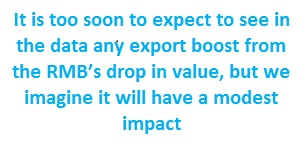Monthly Economy Report
By Andrew Smith
 With all the doom and gloom that has been going on in the global economy in recent months, one would relish the chance to report on some encouraging signs of a turn around. Premier Li Keqiang seemed outwardly optimistic in his recent announcement that in spite of the slowdown in key sectors and the stock market turmoil, the Chinese economy is still on course to hit the government’s official target of 7% for 2015. “China will not see a hard landing,” Li told the World Economic Forum’s meeting in Dalian, commonly referred to as the “summer Davos”. He said managing the “new normal” of slower growth was like playing Chinese chess, trying to balance stimulus with long-term reform.
With all the doom and gloom that has been going on in the global economy in recent months, one would relish the chance to report on some encouraging signs of a turn around. Premier Li Keqiang seemed outwardly optimistic in his recent announcement that in spite of the slowdown in key sectors and the stock market turmoil, the Chinese economy is still on course to hit the government’s official target of 7% for 2015. “China will not see a hard landing,” Li told the World Economic Forum’s meeting in Dalian, commonly referred to as the “summer Davos”. He said managing the “new normal” of slower growth was like playing Chinese chess, trying to balance stimulus with long-term reform.
Unfortunately though, whichever way you slice it, things are still not looking good. As Mark Magnier of the Irish Examiner has pointed out, “Factory production and fixed-asset investment in China were both weaker than expected in August, a month when Beijing temporarily closed some factories ahead of a high-profile military parade. The data released Sunday pointed to continued weakness across large areas of the world’s second-largest economy, heaping more pressure on the government to further stimulate activity.”
Although industrial production grew by 6.1% from the following year in August, according to the National Bureau of Statistics, this came in below the 6.6% median forecast by a group of highly influential economists in a study by the Wall Street Journal. This data falls in line with a further sharp decline in both imports and exports.
According to The Irish Times’ Clifford Coonan, “China’s exports fell in August on the back of weak demand in places such as Europe, with overseas shipments down 5.5 per cent from a year earlier in dollar terms, according to customs data. Imports fell 13.8 per cent, widening from an 8.1 per cent decrease and leaving a trade surplus of $60.2 billion (€53.66 billion).” Seemingly the only good news to come out of the August data was that retail sales were up a bit more than expected.

Although these figures are worrying they hardly came as a shock to most analysts who were already factoring in the persistently weak external demand from regions like Europe and the decline in Chinese citizens’ spending power as a result of the recent yuan devaluation. One of the key things economists will be looking at in the coming weeks and months is whether the devaluation by the People’s Bank of China (PBoC) actually helps to give exports a much needed kick start. “It is too soon to expect to see in the data any export boost from the renminbi’s drop in value in early August, but we imagine it will have a modest impact in any case, given sedate demand overseas and the steeper falls recorded in the currencies of China’s trading rivals,” said Tom Rafferty, Asia economist for The Economist Intelligence Unit in Beijing. Depending on what happens in Europe and North America in particular, it might be some time before the Chinese authorities see a significant impact from their recent monetary policy actions.
In terms of the stock market situation, things haven’t really improved since last month. At the time of writing the Shanghai Composite Index has lost 38.5% of its market value in the last three months, with 19.2% of that coming in the last month alone. This is of course despite the steps that the central authorities have taken to prop up the troubled equity markets in recent weeks. We have seen interest rate cuts, capital injections from state reserve funds and a radical new order to close trading if the markets fall by a certain percentage in one day. According to draft regulations, trading would be suspended for 30 minutes when the market rises or falls by 5%. If the index goes up or down by 7% or more, trading would be suspended for the day. Analysts are undecided whether the move will work. Yang Delong, chief strategy analyst at the Southern Fund, said the idea showed, “the government’s good intentions. The introduction of the circuit-breaker aims at preventing future market plunges and stabilising the market. The A-share market has seen violent plunges recently, and with the circuit breaker mechanism investors would have a cooling period before taking irrational actions.”
This so called ‘circuit breaker’ policy will effectively limit the amount of loss that can be incurred in a very short period of time, which may help to bring some calm to proceedings for a while but it certainly isn’t a magical fix. Going forward it is difficult to predict how long the bearishness will last. There is so much fear amongst both institutional and individual investors, despite the government’s best efforts to reassure them, that it is hard to envisage a rally happening any time soon. Instead, most commentators believe we will continue to see a significant amount of volatility. If the panic in Chinese equity markets spills over to other parts of the world, as it did a couple of months ago, then it could dampen investor sentiments even further.
 With regards to the future of the economy as a whole, most economists are now saying that they expect China to cut required bank reserves again in the next few months and further pressure local government officials to accelerate infrastructure spending in a bid to boost growth. “I’m sure the government’s thinking, now that summer has passed, they can stop worrying about financial volatility and support the real economy,” said Conference Board economist Andrew Polk. “I wouldn’t rule out another interest-rate cut if they thought it would work.” Onlookers are also expecting to see a continuation of the reform agenda that Xi Jinping’s administration has set out. In that sense there were some words of encouragement from one of the country’s leading architects of efficiency reforms. Zhang Xiwu, deputy head of SASAC, told a news briefing that China would centralise state-owned capital in key industries, while restricting state investment in industries not in line with national policies. "We will make more efforts in reforming 'zombie enterprises', long-time loss-making enterprises and in disposing of those low-efficient and non-performing assets," Zhang said. There is a consensus amongst both Chinese and international commentators that such measures are essential if China is going to continue on the high growth path for the remainder of the decade.
With regards to the future of the economy as a whole, most economists are now saying that they expect China to cut required bank reserves again in the next few months and further pressure local government officials to accelerate infrastructure spending in a bid to boost growth. “I’m sure the government’s thinking, now that summer has passed, they can stop worrying about financial volatility and support the real economy,” said Conference Board economist Andrew Polk. “I wouldn’t rule out another interest-rate cut if they thought it would work.” Onlookers are also expecting to see a continuation of the reform agenda that Xi Jinping’s administration has set out. In that sense there were some words of encouragement from one of the country’s leading architects of efficiency reforms. Zhang Xiwu, deputy head of SASAC, told a news briefing that China would centralise state-owned capital in key industries, while restricting state investment in industries not in line with national policies. "We will make more efforts in reforming 'zombie enterprises', long-time loss-making enterprises and in disposing of those low-efficient and non-performing assets," Zhang said. There is a consensus amongst both Chinese and international commentators that such measures are essential if China is going to continue on the high growth path for the remainder of the decade.
--- END ---